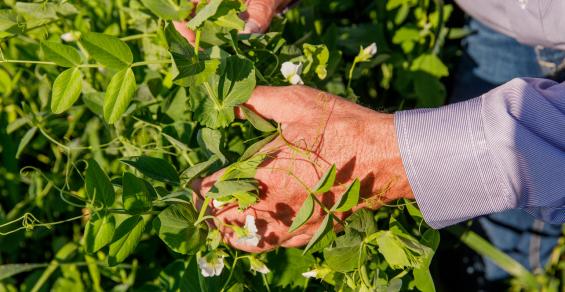Management practices increase soil health while decreasing input costs.
With record-breaking fertilizer prices, farmers may want to reduce their application needs to decrease costs while maintaining their previous year’s production levels. Sustainable options can potentially reduce the amount of fertilizer necessary while improving soil health.
Darrell Oswald, manager of Menoken Farm in Menoken, N.D., says there are different ways to integrate sustainable options to help reduce fertilizer amounts. This “system approach,” as he calls it, includes various soil health principles to use on farms.
Jay Fuhrer, a soil health specialist with the Natural Resources Conservation Service, offers five soil health principles to improve the health of a farm’s soil and increase soil aggregates:
1. Soil armor. Keep the soil covered with green growing plants or residue to protect from erosion.
2. Lack of soil disturbance. Minimize disturbance to the soil by not overgrazing, tilling or overusing chemicals.
3. Plant diversity. Utilize crop rotations of the four crop types — warm-season grass, warm-season broadleaf, cool-season grass and cool-season broadleaf.
4. Continual live plant or root. Keep living roots and green-growing plants in the soil.
5. Livestock integration. Have livestock graze cover crops and crop residues.
Cover crops are one sustainable practice that Fuhrer says incorporates many of the five soil health principles. The use of cover crops protects the soil from erosion and helps recycle nutrients for future cash crops to use.
With proper management, cover crops can improve soil health and crop production, while reducing the use of fertilizer. They can also benefit your cattle herd through the fifth soil health principle of livestock integration. A farm’s cattle herd can graze in the fall, winter or summer on a full-season cover crop.
Oswald says farmers have been slow to incorporate cover crops in the Northern Plains, due to its short growing season. While cover crops can be integrated in multiple ways, Oswald and Fuhrer have gone to 60-inch corn rows, compared to the typical 30 inches, to plant cover crops between larger rows.
This idea allows the cover crop to grow for a full season. It keeps live plant roots, and creates plant diversity and soil aggregates.
The corn crop and cover crop rows will rotate this growing season to fully utilize the previous cover crop benefits. A farmer’s profit is more important than the amount of yield gained from the field, Fuhrer says.
Cover crops can supply a continuous live plant to help secure and recycle nutrients within the soil, while reducing potential nutrient loss from wind and water erosion. Keeping nutrients in the soil is vital to the production of cash crops.
“Keep living roots in soil because every green growing plant is a carbon inlet,” Oswald says.
Keeping nutrients in the soil and allowing growing plants to use them gives the plant the necessary nutrients to potentially decrease fertilizer usage.
Regarding cover crop mixes, Oswald says to ask yourself, “What are your resource concerns, and what are you trying to achieve?” He recommends not only a plant that can trap snow, but also a one you’re comfortable in using and will be cost-effective for you.
Fuhrer also recommends both warm-season and cool-season broadleaf and grass options. Every farm and ranch is unique, so the challenge is to find what works for you.
Oswald notes that cover crops on their own will not eliminate the need for fertilizer but are a management tool to be utilized.
Cover crops and the five soil health principles are all pieces to a puzzle. They work the best using each of them together, creating a “rewarding puzzle,” Fuhrer says.




